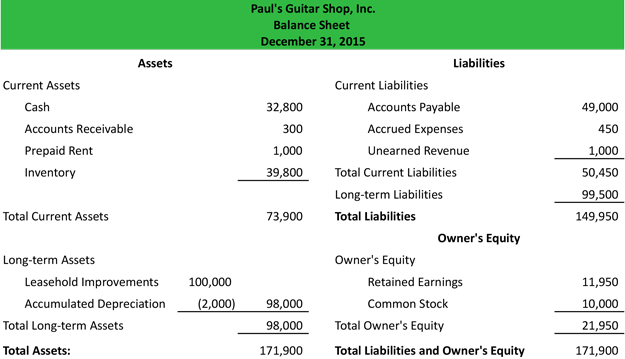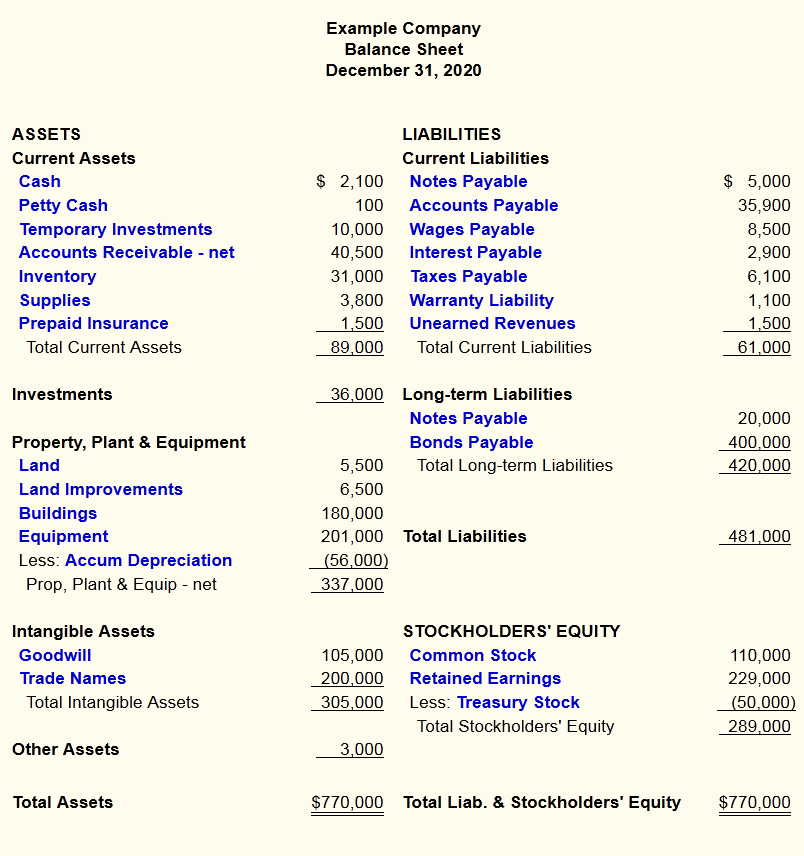Balance Sheet Definition, Example, Formula & Components

Examples of such assets include long-term investments, equipment, plant and machinery, land and buildings, and intangible assets. A balance sheet depicts many accounts, categorized under assets and liabilities. Like any other financial statement, a balance sheet will have minor variations in structure depending on the organization. Following is a sample balance sheet, which shows all the basic accounts classified under assets and liabilities so that both sides of the sheet are equal. Your balance sheet can help you understand how much leverage your business has, which tells you how much financial risk you face.
Constructing the functional balance sheet from the accounting balance sheet
The following chart contains some of the most common metrics used in practice to analyze a company’s balance sheet. The assets section is ordered in terms of liquidity, i.e. line items are ranked by how quickly the asset can be liquidated and turned into cash on hand. If the fundamental accounting equation is not true in a financial model—i.e. The balance sheet does not “balance”—the financial model contains an error in all likelihood.
Owner’s Equity/Earnings
Measuring a company’s net worth, a balance sheet shows what a company owns and how these assets are financed, either through debt or equity. The balance sheet is a report that gives a basic snapshot of the company’s finances. This is an important document for potential investors and loan providers. Department heads can also use a balance sheet to understand the financial health of the company.
Who prepares balance sheets?
These obligations are classified as either current liabilities, due within the forthcoming year, or long-term liabilities, due beyond a year. An unusually high accounts receivable balance relative to revenue may suggest poor collection practices or relaxed credit policies. If Company E has accounts receivable totaling 400,000 dollars against annual revenue of 1 million dollar, this 40% ratio could indicate slower collections, which may impact cash flow. Similarly, if inventory levels are rising faster than sales, there may be an excess inventory issue, leading to potential obsolescence or discounting. These red flags can hint at underlying operational issues or demand constraints, necessitating further investigation into sales and collection processes. Familiarity with your balance sheet will give you an under-the-hood look at company finances.
- A balance sheet is a comprehensive financial statement that gives a snapshot of a company’s financial standing at a particular moment.
- It is helpful for business owners to prepare and review balance sheets in order to assess the financial health of their companies.
- They’re important to include, but they can’t immediately be converted into liquid capital.
- It might seem overwhelming at first, but getting a handle on everything early will set you up for success in the future.
- These revenues will be balanced on the asset side of the equation, appearing as inventory, cash, investments, or other assets.
When investors ask for a balance sheet, they want to make sure it’s accurate to the current time period. It’s important to keep accurate balance sheets regularly for this reason. A lot of times owners loan money to their companies instead of taking out a traditional bank loan. Investors and creditors want to see this type of debt differentiated from traditional debt that’s owed to third parties, so a third section is often added for owner’s debt.
How confident are you in your long term financial plan?
The ending retained earnings balance recognized on the balance sheet equals the beginning balance plus net income, net of any dividend issuances to shareholders. Conceptually, a company’s assets refer to the resources belonging to the company with positive economic value, which must have been funded somehow. It’s not uncommon for a balance sheet to take a few weeks to prepare after the reporting period has ended. We accept payments via credit card, wire transfer, Western Union, and (when available) bank loan. Some candidates may qualify for scholarships or financial aid, which will be credited against the Program Fee once eligibility is determined. Please refer to the Payment & Financial Aid page for further information.

It is crucial to remember that some ratios will require information from more than one financial statement, such as from the income statement and the balance sheet. Below the assets are the liabilities and stockholders’ equity, which include current liabilities, noncurrent liabilities, and shareholders’ equity. According to the historical cost principle, all assets, with the exception of some intangible assets, are reported on the balance sheet at their purchase price. In other words, they are listed on the report for the same amount of money the company paid for them. This typically creates a discrepancy between what is listed on the report and the true fair market value of the resources. For instance, a building that was purchased in 1975 for $20,000 could be worth $1,000,000 today, but it will only be listed for $20,000.
Your balance sheet shows what your business owns (assets), what it owes (liabilities), and what money is left over for the owners (owner’s equity). A balance sheet is a financial statement that contains details of a company’s assets or liabilities at a specific point in time. It is one of the three core financial statements (income statement and cash flow statement being the other two) used for evaluating the performance of a business. This balance sheet also reports Apple’s liabilities and equity, each with its own section in the lower half of the report. The liabilities section is broken out similarly as the assets section, with current liabilities and non-current liabilities reporting balances by account. The total shareholder’s equity section reports common stock value, retained earnings, and accumulated other comprehensive income.
Our intuitive software automates the busywork with powerful tools and features designed to help you simplify your financial management and make informed business decisions. Not sure where to start or which accounting service fits your xero features needs? Our team is ready to learn about your business and guide you to the right solution. We follow strict ethical journalism practices, which includes presenting unbiased information and citing reliable, attributed resources.
Annie is able to cover all of her liabilities comfortably—until we take her equipment assets out of the picture. Most of her assets are sunk in equipment, rather than quick-to-cash assets. With this in mind, she might aim to grow her easily liquidated assets by keeping more cash on hand in the business checking account.
This asset section is broken into current assets and non-current assets, and each of these categories is broken into more specific accounts. A brief review of Apple’s assets shows that their cash on hand decreased, yet their non-current assets increased. When analyzed over time or comparatively against competing companies, managers can better understand ways to improve the financial health of a company. Each category consists of several smaller accounts that break down the specifics of a company’s finances.

